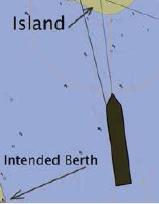201360 Touch bottom event in fog
A tanker, under pilotage, was inbound for port with light winds and visibility reduced to approximately one cable (183 metres) in fog. When the pilot boarded there was no discussion on how the actual berthing manoeuvre was to be performed apart from the fact that the vessel was to execute a starboard swing and berth port side to under a backing manoeuvre once off the destination pier.
Two tugs had been ordered for the manoeuvre. One was secured aft while the second was in the process of securing forward when the manoeuvre was commenced. The vessel was still making way at over four knots when the forward tug was secured. The pilot began giving orders to the tugs in quick succession to turn the vessel, possibly giving an incorrect order that went unnoticed by the rest of the bridge team (even though all were native English speakers). Within two minutes of the forward tug being secured, the vessel touched bottom on an island off the intended berth. The vessel soon came off the ground and there was no pollution.
Findings of the company’s report
* The speed at which the vessel was travelling during the final approaches to the pier was in excess of what was required. The vessel had little sea room to complete the turn, with no margin for error.
* The bridge team appeared to have lost situational awareness. The vessel’s speed was such that the tugs were not able to connect in sufficient time nor was the bow thruster effective in assisting with the turn.
* There was also no time to analyse and question the (possibly) incorrect order given to the tug.
* Due to the incomplete Master-pilot exchange the planned approach speeds and turn initiation were known only to the pilot who was conning the vessel. Therefore the Master and OOW were not able to effectively monitor the pilot’s actions. The pilot’s decision-making became the weak link in a system prone to single-point failure; ie, in the absence of effective monitoring, there is little safety backup for the pilot in the navigation of the vessel.
* The bridge team had not identified or discussed an abort point, turn initiation point or the speeds required for the approach. While this information could have come from the pilot, it should have been included in the vessel’s original passage plan based on the vessel’s characteristics.
 Situation as forward
Situation as forwardtug was secured
